Customer and Billing in focus …
The new cloud delivery model of IT puts much more focus on the customer information, and how to charge / bill for the services.
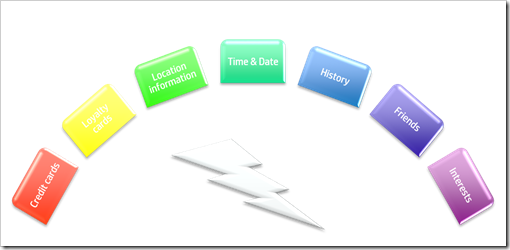 The new economy that comes from online sales, but also from the fact that the customers are easier and easier to identify, and connect to a purchase. The customers use credit cards, and also every possible kind of loyalty card imaginable. This ever growing stream of information is a source of value that is very much unused. With this information there are great opportunities to increase the sales in any enterprise, this has been known for many years and realized by IT systems called CRM systems (Customer Relationship Management systems) but it needs to be elaborated and built out with new and modern functionality. In a modern CRM system you have to classic information, what did the customer buy, when, in what store, maybe even some loyalty information. In addition to this it becomes essential to add information around where was the purchase done, this becomes essential when we add the online shopping dimension to any normal purchase. It is also great if you can add information from social media, like friends, their interest, the interest of the customer itself and more.
The new economy that comes from online sales, but also from the fact that the customers are easier and easier to identify, and connect to a purchase. The customers use credit cards, and also every possible kind of loyalty card imaginable. This ever growing stream of information is a source of value that is very much unused. With this information there are great opportunities to increase the sales in any enterprise, this has been known for many years and realized by IT systems called CRM systems (Customer Relationship Management systems) but it needs to be elaborated and built out with new and modern functionality. In a modern CRM system you have to classic information, what did the customer buy, when, in what store, maybe even some loyalty information. In addition to this it becomes essential to add information around where was the purchase done, this becomes essential when we add the online shopping dimension to any normal purchase. It is also great if you can add information from social media, like friends, their interest, the interest of the customer itself and more.
Adding this kind of information will open a new world of possibilities to sell more and better to the customers. And more sales equals (often) higher revenue and more profit.
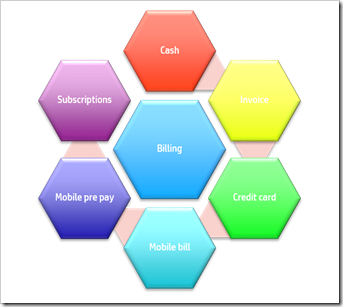 As important as having control of your customers it is also essential to get control of the ways the customers pays; billing … Billing is rapidly moving from a cash with some credit card payments to more or less only credit card payments into a new world where you can pay also with your phone, with tokens earned in other ways through subscriptions or through loyalty.
As important as having control of your customers it is also essential to get control of the ways the customers pays; billing … Billing is rapidly moving from a cash with some credit card payments to more or less only credit card payments into a new world where you can pay also with your phone, with tokens earned in other ways through subscriptions or through loyalty.
Ease of billing/payment will of course result in more sales, but it is not as easy to just add functionality to handle the new way of settle the payment with, even if this is the first essential step for the enterprise. In the new world of internet it is also essential to handle the different personas of a customer, as well as the customers different ways of paying for items. 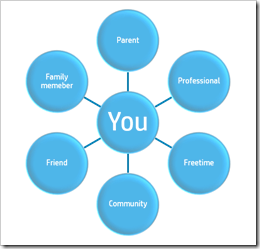 With personas means the different types of personalities the customer have, private person, professional, mother, father, member of the swim team and more … It is quite safe to say that everyone have been out searching for something on the internet on behalf of your kids or in behalf of the local sports club you are active in, and then the preferred search engine company that you are using collects the fact that you now are suddenly very interested in information about blue-whales or quality of water purification systems. The next time you go online you will get this into your results … or suggestions … what is missing here is the fact that when you helped you kid with gathering information about the blue-whale you where actually searching with one of your personas. When this persona functionality available in the future it will enable even more possibilities to targeted sales. More and more of the sales these days are conducted over the internet channel, and there ease and secure payments becomes more and more important, and with the smartphone usage a new and obvious way of buying will be one of the prime choises of every customer; the mobile payment connected to either a mobile subscription or to a pre paid mobile number. Again the obvious need of personas bubble up to the surface; what if/when I only have my company cell phone on me and I need to buy a private-bus-ticket with a NFC or SMS payment? This can sound like a stupid example, but it is a fact already in some places (Helsingborg, Sweden) where you can either buy pre-paid ticket cards in dedicated central places or if you do not have a pre-paid card or the pre-paid card is out of money you can only pay with SMS, no cash or no credit cards are accepted on the bus. So maybe a small dilemma, but still without a persona functionality attached to my company phone billing I can not use the bus. Then there are tons of interesting design and use interface challenges to solve everything, not to mention all the interesting algorithms in the background to keep the personas in control.
With personas means the different types of personalities the customer have, private person, professional, mother, father, member of the swim team and more … It is quite safe to say that everyone have been out searching for something on the internet on behalf of your kids or in behalf of the local sports club you are active in, and then the preferred search engine company that you are using collects the fact that you now are suddenly very interested in information about blue-whales or quality of water purification systems. The next time you go online you will get this into your results … or suggestions … what is missing here is the fact that when you helped you kid with gathering information about the blue-whale you where actually searching with one of your personas. When this persona functionality available in the future it will enable even more possibilities to targeted sales. More and more of the sales these days are conducted over the internet channel, and there ease and secure payments becomes more and more important, and with the smartphone usage a new and obvious way of buying will be one of the prime choises of every customer; the mobile payment connected to either a mobile subscription or to a pre paid mobile number. Again the obvious need of personas bubble up to the surface; what if/when I only have my company cell phone on me and I need to buy a private-bus-ticket with a NFC or SMS payment? This can sound like a stupid example, but it is a fact already in some places (Helsingborg, Sweden) where you can either buy pre-paid ticket cards in dedicated central places or if you do not have a pre-paid card or the pre-paid card is out of money you can only pay with SMS, no cash or no credit cards are accepted on the bus. So maybe a small dilemma, but still without a persona functionality attached to my company phone billing I can not use the bus. Then there are tons of interesting design and use interface challenges to solve everything, not to mention all the interesting algorithms in the background to keep the personas in control.
Sales functionality
The customers will over time not just expect to get better targeted offerings, but also more enhanced offerings based on the information and history gathered. Some classic ways of getting the customers to buy more is to bundle items and give a discount if you buy the bundle. Or buy three of one kind and get one for free. Or just get some percentage discount because you are a loyal customer. Or discount everything or a set of the items and call it a sale. In common for all of the above is that it is tied to one particular time or occation of buying, and to one store. 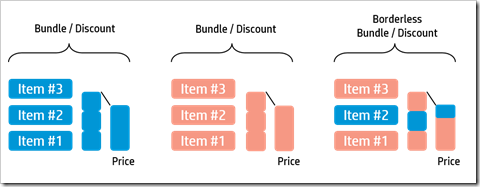 Soon we will see new functionality; like bundling over stores, why would not inter company agreements and collaboration result in item bundling over the store boundaries? As a customer you would be interested in this, you have bought three bottles of fine wine, and as a bonus you get the possibility to bundle it with a plate of cheese that will be delivered by another company, but the bundle makes it attractive as an offering. Creating this kind of inter-company bundles also means that you will share customer information, either direct by simply sharing the customer information stored in the CRM system or indirect by the fact that when setting up the bundle the second company (the cheese company) will know that now the customer have bought a set of wines, and in particular also the type, and volume to be able to use their special knowledge, and recommend the correct type and volume of cheese.
Soon we will see new functionality; like bundling over stores, why would not inter company agreements and collaboration result in item bundling over the store boundaries? As a customer you would be interested in this, you have bought three bottles of fine wine, and as a bonus you get the possibility to bundle it with a plate of cheese that will be delivered by another company, but the bundle makes it attractive as an offering. Creating this kind of inter-company bundles also means that you will share customer information, either direct by simply sharing the customer information stored in the CRM system or indirect by the fact that when setting up the bundle the second company (the cheese company) will know that now the customer have bought a set of wines, and in particular also the type, and volume to be able to use their special knowledge, and recommend the correct type and volume of cheese.
The same principle of bundling will also be applied to the time dimension as we just did to the store dimension. Why would you only be allowed to get the benefits of the bundles if you buy everything at the same purchase? Why is not the bundle offering valid for 24 hours? a week? This is just because historically the selling company did not have the sales/customer information available. Now the technology exits to integrate CRM information in-between different customers, and of course independent of where the CRM system is deployed. It will have to be real time integration, and there will be challenges regarding master data, and or if it should be synchronization/copying of data or if you should allow lookups.
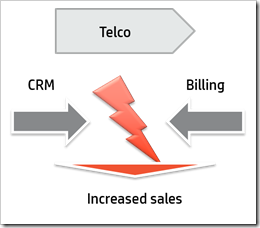 In the same way as always, there will be a need for both types of integrations. The synchronization scenario will be applicable for some companies, but then you have the giants of gathering customer information like Facebook, Google, Yahoo and Microsoft who most likely will sell their gathered information with some kind of lookup functionality, and micro payments. The new players in this arena will be the telecom providers that will both provide customer information that is totally new to all companies, and they will also provide the a new way of billing for goods.
In the same way as always, there will be a need for both types of integrations. The synchronization scenario will be applicable for some companies, but then you have the giants of gathering customer information like Facebook, Google, Yahoo and Microsoft who most likely will sell their gathered information with some kind of lookup functionality, and micro payments. The new players in this arena will be the telecom providers that will both provide customer information that is totally new to all companies, and they will also provide the a new way of billing for goods.
The new information that the telecom operator today have about their customers are a gold mine that is unused. Many people will start shouting about privacy issues and privacy laws, but end of the day that will be solved, and a lot of the information will be available for sales to companies that wants to use it. Information that can be provided is for example, location based information telling where and how the customers are moving, either in real time, or in patterns. This can be used in real time by companies to send out real time marketing offers to potential or loyal customers passing buy a physical store or other place. It can also be used to buy sets of information, for example the top thousand persons that most times during a month passes close to a certain restaurant. Other type of information that the telecom operators are in possession of is the customer internet surfing habits, all surfing on smart phones, and more and more also with mobile broad band connections to lap tops and tablets is passing through the telecom network, and is tagged to a user. (not if the user using a wireless connection)
The other functionality that the telecom operators bring to the party is the functionality of easy billing, every online surfing transaction is as stated above going through the telecom networks, and is in touch with the telecom billing system to constantly determine if the data is allowed. This can be either a subscription that will be invoiced to the customer, or it can be a pre-paid usage, and then need to be constantly monitored.
This functionality can be integrated into both online, and into normal shopping through NFC or SMS payments, and also the same when it comes to online payments, you can use the fact that your telecom operator have some kind of contract with you. (pre or post paid)
What about the functionality behind, the complex combinations price setting parameters can become a real challenge if you need to code it from the beginning, and even if you have more than basic functionality, the borderless, time-less new era will make things extremely complex.
Borderless means to sell/use items from more than one provider in bundles or discount schemas, this will mean contracts in between suppliers, on how to split revenue, length of valid opportunities, history of purchases, and when combined with the timeless dimension also keeper of old non valid offerings.
Timeless means that an offering do not have to be valid just during one purchase activity. For example, if you have a discount offering of buy 3 get one for free, then you normally assume that you have to buy the three items at the same time, but it could be possible to allow patterns where you first buy one item, and then add two more another day (time limited in the offering) and get one for free. This would make the offering a timeless offering.
Where do we get this functionality, normally in a sales/ERP system, where the sales ledger have rich functionality. If we compare to a CRM system it do not always have the same rich sales functionality.
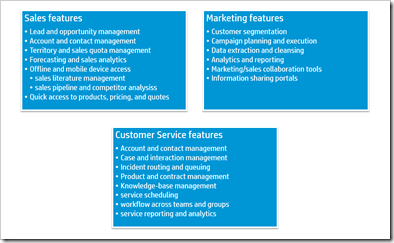 High level functionality needed;
High level functionality needed;
- Customer information
- Purchase history
- Multi Currency
- Advanced Pricing functionality
- Agreements / Contracts
- Usage monitoring
- Tax, where is it sold?
- Inventory for physical items
- Supply chain management (delivery, order promises)
- Supplier items
The marketing, and sales functionality as well as customer service of the MS Dynamics CRM is key of course to improve and increase sales of any kind.
A quick look at this will first disqualify the MS Dynamics CRM product, and you get a feeling for that MS Dynamics AX would do the job. If you then take into consideration that AX also have a full solution for retail that most likely can be used here, even if you buy stuff online with you PC, or with you phone.
Very much of services that will be sold in the future are so called IT services, that is rather consumed online than being delivered, but in the same way as we added timeless and borderless to the new way of selling we will also see patterns where you buy a physical item, and get some IT services to consume. To make it even more interesting some of these services will be subscription based where you will get a volume of consumption every new time period, and there will be an end date to the subscription.
In the telecommunications world that have been standard for a while to sign up for a subscription of SMS, where you get for example 3000 SMS to spend during a month, and every new month it gets reset to the initial amount.
Other examples of consumption could be for example backup, where you either buy a subscription for a certain amount of storage that you pay a fixed price for each month, or you could easy visualize a scenario where you instead pay zero if you don’t backup anything, and then you pay for exactly what you use.
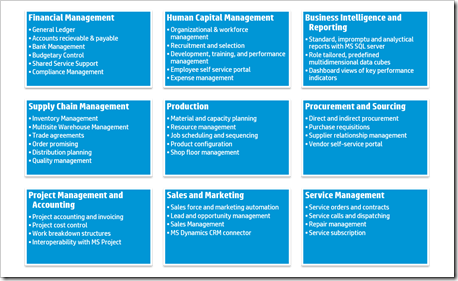 Here we get introduced to functionality that normally is not in a ERP system or a CRM system, but very common in the billing system of the telecom operator. So basically what we are thinking of is that we need to be able to integrate and use functionality [/ provision] from the billing system.
Here we get introduced to functionality that normally is not in a ERP system or a CRM system, but very common in the billing system of the telecom operator. So basically what we are thinking of is that we need to be able to integrate and use functionality [/ provision] from the billing system.
But end of the day, the customer (CRM information) is the main data object here, so the owner of the customer information can sell more. The new integration with the providers of customer information, interests, behavior, friends, etc, etc will be key to future success as well as integration to new payment mechanisms.
The cloud will shift focus …
for the Enterprise Architect
The cloud foundation [will/]have simplified the enterprise architecture in such a way that it is not anymore important to in detail handle everything the technology infrastructure aspect area. This will not only simply the architecture but also the business framework, the normal suppliers/vendors of services will be dramatically reduced when the infrastructure becomes a commodity. The super commodification of the infrastructure aspect area we will see parallel behavior in the Information System aspect area through high standardization of interfaces and behavior in-between software leading to a need of more agile enterprise architecture
As in the nature, the eco system is composed by different ”layers” that have different characteristics, but cannot exist without the layer below. The cow needs the grass as well as the rabbit needs it, in the same way the snake eats the rabbit, and the eagle is consuming the snake. The interesting in this analogy is to remember, that even if we are happy to view an eagle flying in the wild or if we enjoy buing our beef in the supermarket we are depending on green grass
In the same way we in the IT industry can abstract away and really do not work with the details of the lower infrastructure layers, but put our emphasis on the higher layers in the eco-system.
It is natural to first abstract away the aspect area with least business value
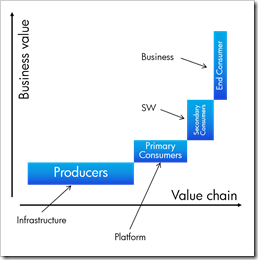 As we suspected, the current business situation shows that we are about to abstract/cover/mist (or put into the cloud) parts of the technology infrastructure aspect area of the business’ IT landscape. There are also other layers that are put into the cloud, platforms, and software.
As we suspected, the current business situation shows that we are about to abstract/cover/mist (or put into the cloud) parts of the technology infrastructure aspect area of the business’ IT landscape. There are also other layers that are put into the cloud, platforms, and software.
When will this then occur? Will we have one cloud that hides everything or how will the reality look? It is of course impossible to predict the future, but it is quite certain that we will have more than one cloud, in the same way as we have more than one HW vendor or more than one SW vendor
And as Sherlock Holmes said in The Sign of Four; “I never guess. It is a shocking habit — destructive to the logical faculty.” To honor this wise (fictive, but wise) man we must at least make an effort into guessing what will happen in the future with some logical reasoning behind.
When we talk about cloud we must as always differ between delivery model and content model, sometimes this becomes a bit confusing but it is quite simple.
There will be some different types of clouds that in general is not always talked about, but will be a type of cloud, or a significant attribute to the cloud of choice.
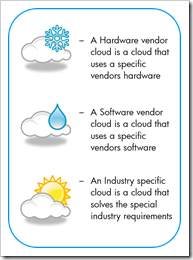 The cloud types that today is common to talk about are Public cloud, Private cloud, Hybrid cloud, and often Government cloud. I believe we need to add what I call Hardware Vendor cloud, and Software Vendor cloud
The cloud types that today is common to talk about are Public cloud, Private cloud, Hybrid cloud, and often Government cloud. I believe we need to add what I call Hardware Vendor cloud, and Software Vendor cloud
We will also get a number of industry specific clouds, for example the Telco cloud. Here we must differentiate between the content and the delivery models. The HW, SW and Industry clouds are content descriptions, and the Public, Hybrid, Private and Government clouds are delivery types that can contain content.
SW clouds, and HW clouds are somewhat depending on each other. The Software vendor are in need of securing access to HW to scale his cloud, and the HW cloud vendor needs software that can be run on the HW cloud
Very often the content layers of clouds that is used is the Iaas, PaaS, SaaS, and sometimes the BaaS
Simplified explanation of content layers;
| IaaS | Infrastructure as a Service | A content cloud where you buy infrastructure services, like storage compute, maybe security services also belong here |
| PaaS | Platform as a Service | A platform as a service cloud is where you buy services that allows you to deploy bespoke software and run it in this cloud |
| SaaS | Software as a Service | Software as a Service is the classic way of offering an application run and operated in the cloud |
| BaaS | Business as a Service | The newest is BaaS where you get a industry/business specific functionality operated in a more or less specialized cloud environment |
Different vendors will have different strength, and hence specialize on different cloud content.
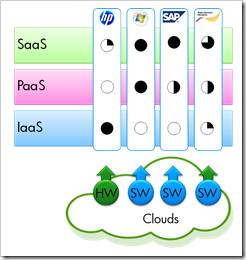 When examining the service offerings that different vendors with their current or potential cloud offerings, it is easy to see that there will be need for more than one cloud provider until interfaces between layers have been better standardized. For example; Microsoft builds independent platforms, that any type of code can run on, but they are still dependent on running their platform on specific hardware. This concludes in the fact that there will be a strong dependency between the SW cloud providers, and the HW cloud providers
When examining the service offerings that different vendors with their current or potential cloud offerings, it is easy to see that there will be need for more than one cloud provider until interfaces between layers have been better standardized. For example; Microsoft builds independent platforms, that any type of code can run on, but they are still dependent on running their platform on specific hardware. This concludes in the fact that there will be a strong dependency between the SW cloud providers, and the HW cloud providers
It is most likely that vendors that complement each other will partner up, and provide joint offerings in different delivery models. You could for example suspect that Microsoft will partner up with HP to deliver their ERP, Microsoft Dynamics AX in the cloud. Microsoft have announced that (or was it rumors?) next version of AX will first be available as a SaaS in the cloud, and secondly available for local deployment. This will fit some enterprises, but not all, some will have regulations or other business benefits that pushes them to chose a different cloud delivery model than Microsoft can offer out of the box. That could be local data requirements that forces the enterprise to have some data locally in a country, and then they “must” go with some kind of distributed cloud delivery that can be used to distribute the installations of Microsoft Dynamics AX.
Who will orchestrate it all?
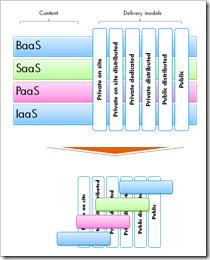 It is obvious that an enterprise will use several different types of cloud delivery models, as well as buying different types of services from them.
It is obvious that an enterprise will use several different types of cloud delivery models, as well as buying different types of services from them.
There are needs that not one type of cloud and delivery model can handle to the best price and conditions.
To make it a bit easier we can drop the content dimension and treat that as different kind of service offerings part of a service catalog
Left will be the delivery models and what kind of delivery model the service provider can provide. This leaves a pretty complex landscape with different services delivered from different locations. There will be for example pure distance in between locations, this will introduce latency, and even more if you are running over the internet, where you could have different number of jumps before you reach the final destination. To orchestrate this you will need a well thought through orchestration model, as well as very strong integration discipline. The integration will become very close to B2B integration in-between different clouds, and are in it self a full chapter of theory, not to be covered here.
Delivery models of clouds;
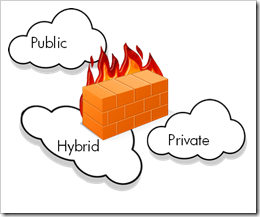 Normally when talking of different types of cloud the discussion is around sourcing models, this means who owns the cloud, and that is of course important from a capital expense point of view, but in the sourcing model naming also implies where the cloud is run from.
Normally when talking of different types of cloud the discussion is around sourcing models, this means who owns the cloud, and that is of course important from a capital expense point of view, but in the sourcing model naming also implies where the cloud is run from.
Private cloud runs from the enterprise premises, a Public cloud will be run from wherever the cloud provider have their center, and a Hybrid cloud will be something in between.
In this naming you very fast can make an assumption on where your data will be located as well as the level of control you an an enterprise will have over the objects in the cloud. (security)
The security of cloud is today the one big thing that holds back the commercial explosion of the concept. The other thing is location of data. We noticed that in the so called Blackberry data ownership dispute in 2010, the Architecture of the Blackberry ”cloud functionality” and the location of data have affected much of the thoughts behind how to architect the cloud solutions of the future.
Globality and Specialization
With the play of global enterprises we will get the benefit of using different clouds for different parts of the IT landscape. Maybe the ERP system will be run in a specialized cloud, the bespoke systems in a private cloud, the integration engine again in a special cloud, and the different staging environments for testing new functionality before it enters the production environment might be in a public cloud, because it will anyway run old data, that is not security sensitive.
If you are a multi location enterprise you might need multi site cloud delivery. The normal reason is regulations of data, but it can also be due to less latency in the network. One serious question to as the specialized cloud delivery vendor is if they can support multiple locations of data. If this is hard or impossible, the large global cloud vendors like HP do most likely deliver support for the same kind of applications with a choise of distribution of implementation and data.
Time have passed quicker than usually, already now we can see companies that more or less do not need local servers, most will want some kind of local servers but some less critical systems can be run in public clouds with lower SLAs and generally a feeling of less security.
The natural thing for an enterprise is to use cloud services for the less critical services
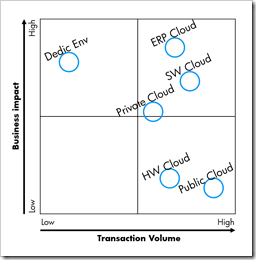 If we read the business impact – transaction volume diagram, or we can also call it the commodity diagram, over the time dimension we will notice that the cloud services moves, the HW Cloud for example moves from a high business impact down to a less significant position in the lower right quadrant.
If we read the business impact – transaction volume diagram, or we can also call it the commodity diagram, over the time dimension we will notice that the cloud services moves, the HW Cloud for example moves from a high business impact down to a less significant position in the lower right quadrant.
We should read this as for the business the availability of the HW cloud is an easier to risk mitigate than for example an ERP Cloud.
The availability of different clouds with different characteristics gives us a new type of Enterprise Architecture as well as a new business partner landscape in-between the Enterprise and the Vendor.
Compare the IT cloud to the utility business, they deliver power, and with a highly standardized interface (two holes in the wall. This is the simple example, but if you are talking to a large enterprise that is very electricity intensive, they will have to write special agreements with the utility vendor, and the delivery can be a bit unique, the same for other special occasions, like a DC that needs to have the possibility to be powered from two independent energy sources/grids
Compare the IT cloud to water from the tap. Also something you pay per usage, and we all consider as something we can easily get from one or another supplier, but we expect the interface at home to be the same.
We are in these cases looking at price / quality / and terms and conditions, because that is the main things that change if you look at different suppliers. When an enterprise have special requirements you get a special solution. If you have the need of extreme water usage you would for example need to build out the normal supply of water to a high capacity supply pipe. The TI (Technology Infrastructure) abstraction of the enterprise architecture will over time become more and more commoditized, and then will the same attributes applied on buying these services.
Commoditization (also called commodification) occurs as a goods or services market loses differentiation across its supply base, often by the diffusion of the intellectual capital necessary to acquire or produce it efficiently. As such, goods that formerly carried premium margins for market participants have become commodities, such as generic pharmaceuticals and silicon chips.
We will see the same happen with cloud services. The grade of commodification will vary with the placement in the enterprise value chain, and the TI will be abstracted away long before the other aspect areas of the enterprise architecture
Furthermore the business partner landscape will change
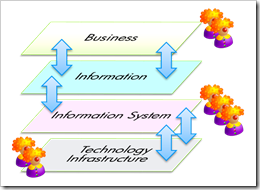 In each enterprise abstraction (B,I;IS;TI) there can be one or more suppliers of services.
In each enterprise abstraction (B,I;IS;TI) there can be one or more suppliers of services.
There are dependencies between the abstraction layer, and when you hand a scope to a supplier you also informally understand that the supplier will not be happy if their scope becomes smaller.
Hence the scope of a supplier is depending on the interconnected layers (above / below) and the delivery in these areas.
When the TI abstraction area is removed from the equation due to commoditization the enterprise partner landscape will dramatically change. A common way will be to make sure the enterprise owns knowledge in the commoditized area, to be able to handle exceptional situations.
We have now noticed that it is not possible to be a strategic partner in the ”removed” abstraction area because the enterprise do not need to interact with the commoditized area.
As well as the way of creating Enterprise Architecture
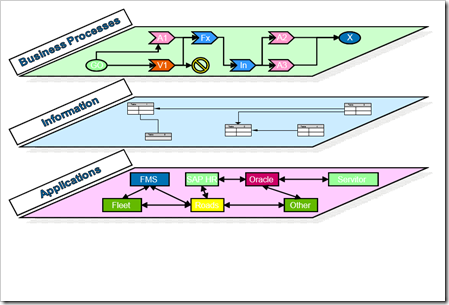 To notice is that the sole business aspect area that is not in focus of vendor help is the Information aspect area, this shows how important it is and will be to understand exactly how information flows with the business processes, with the help of the information systems.
To notice is that the sole business aspect area that is not in focus of vendor help is the Information aspect area, this shows how important it is and will be to understand exactly how information flows with the business processes, with the help of the information systems.
With the information in the center of the enterprise the knowledge, and behavior of the enterprise architecture will move into a facilitating role in-between business activities and application functionality.
There will be a new focus on new requirements on both speed of creation, the involved parties that creates the architecture as well as on interaction with the business. Business interaction will drive the enterprise architecture, meaning that experience of interaction with business and software functionality understanding will supersede the now out abstracted technology knowledge.
Even the ERPs have been evolved to a grade where it is possible to tread the services/functionality as exchangeable service to gain advantages
The EA will now also become more and more focused on external collaboration
With the shorter business and product cycles in the market, the information system support of the enterprise also needs to keep up the speed.
Most likely this means that instead of building a lot of bespoke functionality we are looking on integration of standard services that quickly can bring new functionality or new information transformation.
The uniqueness of an enterprise will be in how and what services are combined to the full enterprise architecture, in combination with business services, business processes and activities as well as how the organization is designed. This together with the outlined information objects, and the corresponding integrated standard information system services is the new enterprise architecture.
This new architecture will live in a landscape build of different orchestrated clouds that is orchestrated and operated by the provider with the best method and tools to monitor, and with automatization give advantages to the enterprise.
Conclusion;
Change of business partners;
- The HW vendors will own a high transaction volume cloud that will be highly commoditized, and hence they will not be a strategic partner to the enterprise.
- The enterprise will partner with the vendor that provides higher business impact services, note that this will not have to be a cloud provider
- HW vendors will need SaaS services to sell their hardware in the future
- There will be a need for private distributed clouds
- The telecom companies will play a large role in the end to end SLAs of the future
Enterprise Architecture will shift focus;
- A switch of focus will occur, the technology infrastructure abstraction layer will very much disappear, and the architecture of the enterprise will take a big jump into a focus of business services, and how they are realized with information system services.
other things to notice;
- The ISV is depending on a HW vendor to be able to build their cloud
- Security, and location of data will be essential, that means that either small local cloud providers will have a niche or the enterprise will use a global HW cloud provider to handle the enterprise data
- The end to end SLAs need to be provided in a new way, including telecom providers as well as every service provider in their own cloud
- There will be a renewed focus on non functional requirements in-between services
- Monitoring of IT will mean something different for the next generation of enterprises
- New requirements will affect the integration area, cloud integration
Cloud service models of today?
The last years we have all read, and talked about cloud computing. That everything will be executed in the cloud … To some extent that is probably true, but for an enterprise there will be systems that there are no business case in moving into the cloud, as well a there are systems that definitely needs to be executed from a cloud platform.
Many different types of cloud will exist, and I argue that a company benefit from selecting a mix of these.
The first, and most simple version of cloud is the hardware cloud (IaaS or Infrastructure as a Service), the characteristics of this cloud is that you buy the amount of computing / hardware that you need for the moment, and can release capacity that is not needed with very short notice. In a perfect world the scaling up, and down would be automatically and in real time, and depending on what service level agreement (SLA) the buyer have with the cloud vendor.
e.g. if performing for example computing intensive supply chain planning calculations the cloud would understand that to keep the SLAs it need to scale up the allowed performance. This sometimes also is called “cloud burst”. One big difference in the IaaS cloud is how you pay for your services, the most common is that you pay for allocated resources, but some cloud providers actually invoice per used resource unit. If the cloud bursting shall work it is very important that the invoicing mechanism is per usage and not per reserved capacity.
The next common abstraction level in the service model dimension is the PaaS or platform as a service, here we have abstracted away the hardware, and get access to a computing platform like a database, or a web server or a execution runtime engine. When reaching this abstraction level it can be interesting just to quickly reflect on the differences of IaaS and PaaS from a cloud owner perspective. The IaaS will most likely be owned by the hardware vendor, that owns and manufactures the computing platforms, or the storage. The margin that these vendors can play with to get the correct price is directly dependent on the hardware. In the second case the PaaS we will on top of some hardware add a layer of executional functionality like a database or a runtime execution engine on where some kind of software will execute.
When we look at the third abstraction layer of cloud in the same dimension we will come to the SaaS or software as a service level and this is where the service offered is access to a piece of software. Examples of this can be email, CRM, and even ERP systems. Now we are looking at a cloud that is handled by a software company. The margin that now is regulating the sell price of the services offered by the cloud vendor comes from the licenses that a using company have to pay. The hardware is still needed, as well as the platform to execute the software upon. We now have three different service cloud models that spans from one extreme of hardware only to software only. I will now argue that this is not the end of this dimension. To come close to the end we need to add a fourth cloud type that I will call the industry solution cloud (Ind aaS, Industry solutions as a service)
The highest business value is received when a company selects to run a industry solution that is standardized and managed in a separate cloud, a Industry solution cloud. In this end of the service dimension the cloud provider will by definition own a solution that is a compilation of several software entities that together result in a higher value to the end customer than each piece of software on it own. To be able to run this successfully the added value need to be higher than the cost of software license, platform cost and hardware cost.
So far I have not seen any clear provider of industry cloud, but I am sure that they will soon turn up. When there are a white spot in the market it will be filled by someone very soon, but the reason that we don’t see anyone here yet might be that there are no mature offerings that have a good enough business case. It is quite easy to argue against the IndaaS, for example the most common argument that I have heard is that you will not get any differentiation to your company if you chose this route. I believe that the IT industry in mature enough to understand that a solution in a IndaaS will have to be a set of black-box components that have well defined interfaces and can be exchanged for some other black-box component that will interact with the rest of the components in the same way. One ERP system that is closing in, and can be argued to play in this area is the Microsoft Dynamics AX where you have industry solutions, and also a powerful workflow engine where you can exchange sertain functionality in the standard ERP system with your own unique solution that would give the enterprise that key advantage that they need over their competitors.
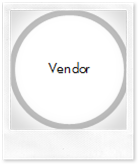 Sometimes I use the term “Vendor Cloud” to describe a type of cloud that is in between the SaaS and the IndaaS, example of this could be a ERP vendor that have a cloud where the customers can run the ERP suit of software. This definition limits the control to the vendors software, and hence it still is a license play when it comes to cost, but some very large software vendors own suits of software that makes it close a industry cloud, but I think the difference is in the fact that an ERP system in it self do not give a business value, the business value is received when all the parameters, and most external integration are in place.
Sometimes I use the term “Vendor Cloud” to describe a type of cloud that is in between the SaaS and the IndaaS, example of this could be a ERP vendor that have a cloud where the customers can run the ERP suit of software. This definition limits the control to the vendors software, and hence it still is a license play when it comes to cost, but some very large software vendors own suits of software that makes it close a industry cloud, but I think the difference is in the fact that an ERP system in it self do not give a business value, the business value is received when all the parameters, and most external integration are in place.
Google street view
:-) yesterday I drove north from Copenhagen and saw (what I think was) the Google Street View car … shall be fun to see if they captured me
Retail Rumblings
Comment on; Is there a Future for a Commerce Cloud? from Retail Rumblings
 I think that “the cloud” is here, and will stay … or has been here for a while, just think about all the mainframe applications that is hosted and run in a distant location somewhere … isn’t that the cloud? What have happened lateley (the last years) is that a standard of accessing and govern services run from a distance, and by other organisations is eveolving.
I think that “the cloud” is here, and will stay … or has been here for a while, just think about all the mainframe applications that is hosted and run in a distant location somewhere … isn’t that the cloud? What have happened lateley (the last years) is that a standard of accessing and govern services run from a distance, and by other organisations is eveolving.
We can call this cloud computing, we can call this service oriented architecture or we can call it enhanced mainframe computing :-) but to be really honest it is all about experience, and ability to use standards to lower the risk, and deliver business driven applications.
I think that the days when IT departements was in charge of the enterprise solutions is coming to an end. We are now in the days when, finally, the business will drive the functionality. As an example look at the 2009 version of Microsoft Dynamics AX, where there is an easy to use workflow engine (based on standard) it is integrated with the SharePoint software so that it is easy to publish and handle the information from remote sites.
 The challange to come is the quality of the services, and how to govern this; SOA Governance if we dont have a good way of handling the quality and the responsibilities, and everything around that the cloud computing will not be as successful as it could be. It is in a way two different kind of transactions that needs to be taken into consideration; business critical, and non business critical.
The challange to come is the quality of the services, and how to govern this; SOA Governance if we dont have a good way of handling the quality and the responsibilities, and everything around that the cloud computing will not be as successful as it could be. It is in a way two different kind of transactions that needs to be taken into consideration; business critical, and non business critical.
But back to the fact that business and IT need to collaborate; I think that an obvious example of this can also be seen inside Microsoft Dynamics AX 2009 where alerts, and different levels can be altered by non IT people. This might be true for SAP, Oracle, and many other business applications, and if you have good examples, please tell me.
so in summary; Yes there is a Future for a Commerce Cloud. The correct business transactions and IT infrastructure will be moved into the cloud first, but when the cloud computing reaches higher maturity we will se more and more business critical solutions moving in there also.
How to ensure success in the retail industry
 Everyone knows that we have a bad economic environment at the moment. This affects the behaviour of people, and companies. People spend less, and the companies invest less … I’m not into economics so I shall not even try to explain to myself what effect this will have, and I will not even dream of explaining it to any potential readers out there …
Everyone knows that we have a bad economic environment at the moment. This affects the behaviour of people, and companies. People spend less, and the companies invest less … I’m not into economics so I shall not even try to explain to myself what effect this will have, and I will not even dream of explaining it to any potential readers out there …
But I will accept the fact that this has an effect on the companies; less money in results in a spiral going down. We definitly see evidence that not all companies are showing bad figures, some are even doing better at the moment than the same period last year :-) One example could be RnB from Sweden that both in March and during the period December 2008 to end of February 2009 is doing better than the same period the year before. There can be a number of factors behind this, and I do not know the details in why RnB is successful.
Generally in the business environment of today there are some things that should be tested
- New sales channels; web, subscriptions, …
- Better customer control; CRM, BI
- Improve customer loyalty;
- Point of Sale system; Improved customer experience, better service
- Trade Promotion Management
In these days it can be hard to get the budget to implement new IT systems to support these initiatives but there are ways.
 Look at outsourcing of some of your applications as a tool to cut the operational cost. If you manage to lower your cost through the standard outsourcing activities you will get money to invest in the future of the business.
Look at outsourcing of some of your applications as a tool to cut the operational cost. If you manage to lower your cost through the standard outsourcing activities you will get money to invest in the future of the business.
Implementing one or a number of the above suggested areas will increase the sales in different ways.
The POS (Point of Sale) system will ensure that you can collect more information about how, what, and when your customers are shopping. With a customer loyalty program you can connect the POS information with your CRM and BI systems and optimize the offerings to each customer.
But what IT system should I chose you may think… I will not make a firm recomendation to you without having the background and context of your business, but some recomendations (not silverbullets, and not very unique)
- What fits in my business strategy
- Merger and Aqusitions
- Organic growth
- Global precense / New markets
- What fits in my IT strategy
- What IT system have the needed functionality
- 150% functionality or 90% plus amendments
- What is the total cost of ownership of the system
- Some of the systems out there might not fit the size of your organization, ot the skills that you have in your company might be a bit wrong
Trade Promotion Management (TPM) an important part of CPG business
My last year have been filled of products, and some of them had a obvious fit in the system map in almost any company. Advanced planning systems has developed a lot in the last years, the product that Kineticsware have (KAPS) is a new generation advanced planning system, that handles the input information in a new way, and uses new algorithms to speed up the calculations, it has a great interface to present the information to the end user. It also gives the posibility to to "What if" scenarios because it have the new way of doing the calculations that gives the speed.
Another very interesting functional area that I personally had not spent a lot of thoughs of is the Trade Promotion Management. After reading research from companies like AMR, AT Kerney, SAP, Kineticsware, and Infosys it is obvious that this area have need for end to end solutions. There are some products out on the market that claims to have the holistic view of the challange. I am sure that many of the big consultant firms, like EDS, can provide expertise in the area but with the area being quite new to the product companies (Microsoft, SAP, Oracle …) the interesting thing here is that new products have the possibility to position themself in the market, and make a big difference. So … what is Trade Promotion Management? TPM is the business process of managing incentives between manufacturer and retailer to improve the sales of a product. That can at first sound quite easy, right? But when you start to dig into the problem space you soon find that it is more complex to get right than you imagined in the beginning. And that insight is usually the first sign of that some automated support might be good to have. Do everyone need a new product? No of course not, but the market now offers products for companies in every size from the small to the large enterprises. When scanning the market for good solutions I think it is important to find a solution that gives the functionality that you need, and can grow with your business. It might be the correct thing to go for SAP if you have the strategy of using SAP solutions, but a Microsoft solution will be a extremly good alternative for many companies. There are of course other vendors that should be evaluated, but do not forget to take things like stability, scalability and other non-functional aspects into consideration as well as the functionality.
The ROI of implementing automated support of the TPM activities is very often very good, but do not forget to apply som organisational changes when you are doing it also so that you actually use the new features. And the change of business processes is not only in the sales and marketing department … it will affect more parts of your business. I think that a TPM solution can be the innovation that often is talked about in BPR that is needed to lift the company performance to a new level. If/when you get that advantage of the solution it is also possible to repeat the activity and continue to be successful.
Upgrade cost of the ERP system (part 2)
When should we upgrade our Enterprise software? It can be the ERP system, the CRM system, the business ware house or some other enterprise software that was quite an investment to upgrade. The first thing I really hope that a modern implementation gave was a modularisation of the add-ons and changes that was done to the standard system to fit the company needs. The really first question to ask when the upgrade or not to upgrade question comes to the agenda is probably, why? Why should I spend time and money on the upgrade right now? Is it to get the functionality that I have done manually? Is it because some functionality have been introduced that I have made as amendments, and by upgrading I can get down the maintenence cost? Is it because the software vendor will not give support on the product any more? Another thing that have to be included in all upgrades is; the business case! … what is the time for ROI (return of investment) ?
I think that an upgrade is a perfect point in time to ask some other questions also … – Do I really need all the functionality that I have? Are we the best to perform this service? By asking questions like this it is easy to identify if the business strategy and the it-implementation is aligned. Often it do not take very long time before the business and the IT strategies slowly glides away from each other, even though everyone knows that the IT is "only" there to support the business.
When should I then upgrade my system? One thing for is true; It will never be a perfect time to upgrade a business essential system! You will get arguments like; "It will steal time from my normal work" , "We do not have time to do that at the moment, we just have to do this first" … and excuses like that. But … have you thought about the cost of additional resources that the business have to use to cover the lack of functionality or the stability that you will get with the new version? IT is there to support the business and occationaly also be the inovation that gives the business advantage. But if the gap between business and IT becomes to big then the cost of daily bridging that will also grow. You could argue that it is somewhat exponential because you will have to have overlapping manual functionality together with the system functionality. The conclusion of that is that keeping the IT up to date is not a cost it is an enabler for IT inovation and reducing the cost of the resource bridge.
Microsoft Dynamics AX the ERP-Ruby on Rails?
A big operational expense for a lot of enterprises today is the amendments that are done to the ERP system that is installed. You have the standard changes to reports, and information views. You have the as common additions of fields to the database and to the forms. The Forms, just think about how hard it can be in "legacy" ERP systems to add or change a field … from 10 characters to 15 characters. The time needed to change the system is in direct relation to the cost of changing the system.
With the Dynamics AX platform we have a reliable platform for developing scalable, secure, and functional rich products. The last years we have read and heard a lot about Ruby on Rails, RoR is/was perhaps the biggest change to web development this decade. I think that Microsoft Dynamics AX provides at least the same advantage over other ERP systems with its X++, Morph X and the integration to the rest of the Microsoft stack. You might have looked at the MVC (Model-View-Controller) patterns that RoR supports, and if you like that you should look at the code that is in the Microsoft Dynamics AX application, it is a joy to read the code, and it supports the most design patterns that you can find in any book.
Yes there are things that a framework like RoR will do better than AX, and the other way around, but that is not the point here, the point is to understand the advantage that products developed on a robust framework like the Microsoft Dynamics AX framework delivers compared to no framework at all or to a legacy framework that do not provide all the built in features that you get with the Microsoft Dynamics AX framework.
With a product developed for the Microsoft Dynamics AX ERP system you will for "free" get scalability, security, governance, and reliability and lower maintenance cost. That means that most of the non functional attributes of the product is already taken care of. The product vendor will have to make sure that the product is tested and made sure that the basic code is correct ;-)
ISVs like Kineticsware are building enhancements to the AX product that result in extreme ROI calculations for the customers that implements them. Will the customers need changes to the base product? Yes almost every customer wants to have some amendments made to the base product, and here is one of the big wins when going for MS Dynamics AX … they will get faster and cheaper changes! Both short term and long term.
What about future mergers or expansions or integrations? … will that be an issue to take the requirements of this into the existing system? Will it be expensive to change all the screens where the employees are working? as an CIO/CEO/CFO, take things like this into consideration …
Internet Explorer 8 (ie 8)
I just tried Internet Explorer 8 from Microsoft, and yes it is still Internet Explorer, and yes it has some new features, but is it something that will change my life? No, probably not, but I really like the activities functionality that for sure will make my life a bit easier, and not fill my explorer with tabs.
Some new functionality have been introduced;
- Activities menu
- Web slices
The activities menu you can see an example of here to the right, its a nice functionality but not revolutionary, and the web slices seems to be nice functionality but the webpages need some adaptaions to support it. And yes … it is Microsoft so there will be pages out there that support the functionality.
In my example I marked the text "Kineticsware" and tried to look it up on the maps, but it didnt get it right … (There are ofcourse explanations to this, but somewhat fun at least)
The wrapup of this new version is that, sure it is fun with a new version, but at first look this version does not give me personally very much, I have not used it long enough to be able to determine if it is faster and the reliability wouldnt be fair to jsutify at the moment when it is a beta version.
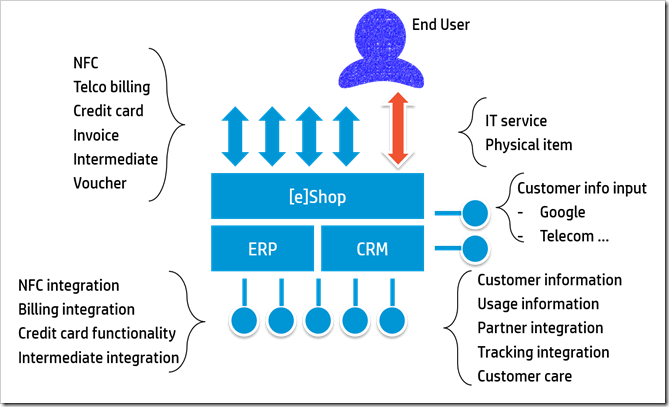
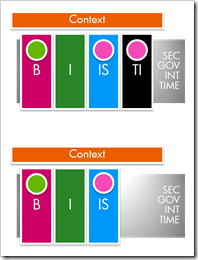
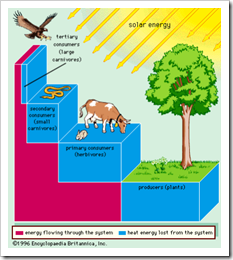
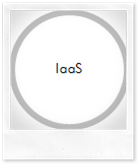
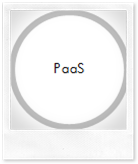
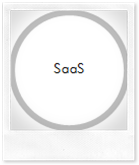
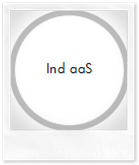

You must be logged in to post a comment.